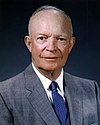
The LNER Class A4 is a class of streamlined 4-6-2 steam locomotive designed by Nigel Gresley for the London and North Eastern Railway in 1935. Their streamlined design gave them high-speed capability as well as making them instantly recognisable, and one of the class, 4468 Mallard, holds the record as the world's fastest steam locomotive. Thirty-five of the class were built to haul express passenger trains on the East Coast Main Line route from London Kings Cross via York to Newcastle, and later via Newcastle to Edinburgh, Scotland. They remained in service on the East Coast Main Line until the early 1960s when they were replaced by Deltic diesel locomotives; they themselves proving to be worthy successors to the A4s. Several A4s saw out their remaining days until 1966 in Scotland, particularly on the Aberdeen – Glasgow express trains, for which they were used to improve the timing from 3.5 to 3 hours.

The National Railroad Museum is a railroad museum located in Ashwaubenon, Wisconsin, US.

The London, Midland and Scottish Railway (LMS) Coronation Class is a class of express passenger steam locomotives designed by William Stanier. They were an enlarged and improved version of his previous design, the LMS Princess Royal Class, and on test were the most powerful steam locomotives ever used in Britain at 2,511 dbhp. The locomotives were specifically designed for power as it was intended to use them on express services between London Euston and Glasgow Central; their duties were to include the hauling of a proposed non-stop express, subsequently named the Coronation Scot. The first ten locomotives of the Coronation class were built in a streamlined form in 1937 by the addition of a steel streamlined casing. Five of these ten were specifically set aside to pull the Coronation Scot. Although a later batch of five unstreamlined locomotives was produced in 1938, most of the ensuing Coronation class were outshopped as streamliners. From 1944 until production ended in 1948, all-new engines were built in unstreamlined form and all the streamliners had their casings removed. The last of the 38 locomotives was completed in 1948.

LNER Class A4 4468 Mallard is a 4-6-2 ("Pacific") steam locomotive built in 1938 for operation on the London and North Eastern Railway (LNER) at Doncaster Works to a design of Nigel Gresley. Its streamlined, wind tunnel tested design allowed it to haul long distance express passenger services at high speeds. On 3 July 1938, Mallard broke the world speed record for steam locomotives at 126 mph (203 km/h), which still stands today.
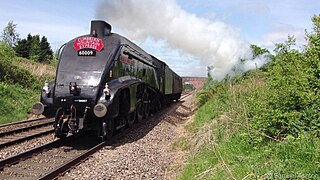
60009 Union of South Africa is a LNER Class A4 steam locomotive built at Doncaster Works on 16 April 1937. It is one of six surviving A4s. Its mainline certification expired in April 2020. As the locomotive is subject to a boiler inspection, it was moved to the East Lancashire Railway as the original plan was to keep it running there until the end of boiler certificate and then send it somewhere else for static display, but a cracked boiler tube forced it into retirement prematurely. It was briefly renamed Osprey during part of the 1980s and 1990s due to political opposition against apartheid in South Africa at the time.

Locomotion, previously known as Locomotion the National Railway Museum at Shildon, is a railway museum in Shildon, County Durham, England. The museum was renamed in 2017 when it became part of the Science Museum Group.

LNER Class A3 4472 Flying Scotsman is a 4-6-2 "Pacific" steam locomotive built in 1923 for the London and North Eastern Railway (LNER) at Doncaster Works to a design of Nigel Gresley. It was employed on long-distance express passenger trains on the East Coast Main Line by LNER and its successors, British Railways' Eastern and North Eastern Regions, notably on The Flying Scotsman service between London King's Cross and Edinburgh Waverley after which it was named.

The London, Midland and Scottish Railway (LMS) Ivatt Class 2 2-6-2T is a class of light 'mixed-traffic' steam locomotive introduced in 1946.

4464Bittern is a London and North Eastern Railway (LNER) Class A4 steam locomotive. Built for the LNER and completed on 18 December 1937 at Doncaster Works as works number 1866, it received number 4464. After that it was renumbered 19 on 16 August 1946 under the LNER 1946 renumbering scheme, and finally 60019 by British Railways on 10 October 1948, after nationalisation. Of the 35 strong class, it is one of six to survive into preservation but it is one of only two currently scheduled to be certified for mainline use.

LNER Class A4 4498 Sir Nigel Gresley is a preserved British steam locomotive built by Doncaster Works for the London & North Eastern Railway in 1937.

4489 Dominion of Canada is an LNER Class A4 steam locomotive. It is a 4-6-2 locomotive built to the same design by Sir Nigel Gresley as the more famous Mallard. There were 35 A4 locomotives built in total. Originally numbered 4489, it was renumbered 10 on 10 May 1946, under the LNER 1946 renumbering scheme of Edward Thompson and, after nationalisation in 1948, British Railways added 60000 to its number so it became 60010 on 27 October 1948. It was renumbered back to 4489 following a cosmetic restoration at the National Railway Museum in York during late 2012 and early 2013.

The Great Eastern Railway (GER) Class Y14 is a class of 0-6-0 steam locomotive. The LNER classified them J15.
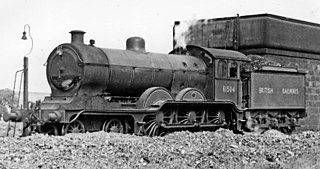
The Great Eastern Railway (GER) Class S69, also known as 1500 Class, and later classified B12 by the London and North Eastern Railway (LNER) is a class of 4-6-0 steam locomotive designed to haul express passenger trains from London Liverpool Street station along the Great Eastern Main Line. Originally they were designed by S. D. Holden, but were much rebuilt, resulting in several subclasses.
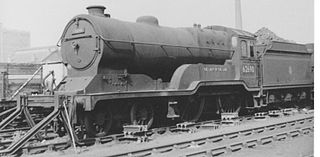
The Great Central Railway Class 11F or Improved Director Class is a class of 4-4-0 steam locomotive designed by John G. Robinson for passenger work. The LNER classified them as Class D11 from 1923. They were based on the earlier GCR Class 11E "Director" class.

The Great Northern Railway (GNR) Class N2 is an 0-6-2T side tank steam locomotive designed by Nigel Gresley and introduced in 1920. Further batches were built by the London and North Eastern Railway from 1925. They had superheaters and piston valves driven by Stephenson valve gear.

The London and North Eastern Railway (LNER) Thompson Class L1 was a class of 2-6-4T steam locomotives designed by Edward Thompson. The prototype no. 9000 was built in 1945, but the remaining 99 were built under British Railways jurisdiction in the period 1948–1950.

The GER Class T26 was a class of 2-4-0 steam tender locomotives designed by James Holden for the Great Eastern Railway. At the 1923 grouping they passed to the London and North Eastern Railway, who classified them E4. Eighteen survived into British Railways ownership in 1948, and the last was withdrawn in 1959, making them the last 2-4-0 tender locomotives at work in Britain. Their BR numbers were 62780–62797.

The Caledonian Railway 264 and 611 classes were 0-4-0 saddle tank locomotives designed by Dugald Drummond and built by Neilson and Company in 1885. Later examples were built at St Rollox Works under the direction of John F. McIntosh in 1895, 1900, 1902 and 1908.
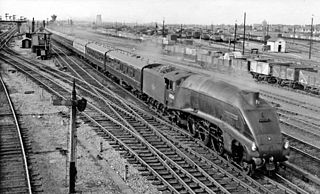
LNER Class A4 60034 Lord Faringdon was one of 35 Doncaster built Class A4 Gresley Pacific steam locomotives.

The Great Northern Railway Class A1 1470 Great Northern was the first of 52 A1 class locomotives. It has also represented three distinct stages in the history of the British 4-6-2 "Pacific" steam locomotives designed by Nigel Gresley for the Great Northern Railway (GNR), a constituent company of the London and North Eastern Railway before the amalgamation of 1923, for which they became a standard design. Eventually Great Northern was completely rebuilt as Class A1/1.
























